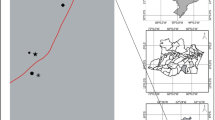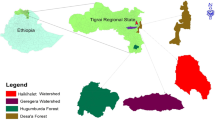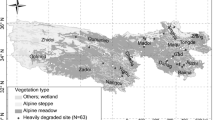Abstract
This paper examines the dynamics of organic matter and nutrients under planted fallows of Gliricidia sepium in South Western Nigeria, as an investigation into the behaviour of soils under such fallows. Data on soil characteristics were collected from thirty fallow fields ranging in age from one to eight years. The data sets were described using the descriptive statistics. Furthermore, the relationships between the soil properties and the age of fallow were evaluated with simple bivariate correlation analysis. Compared with published data and trends in natural fallow, the study shows that the progress of the planted fallow leads to greater organic matter build-up and increase in nitrate-nitrogen and potassium concentration in the soil. It also shows that the biomass retain greater amount of nutrients during the fallow.
Similar content being viewed by others
References
Adejuwon JO and Ekanade O (1987) “Edaphic component of the environmental degradation resulting from the replacement of tropical rainforest by field and tree crops in SW Nigeria” International Tree Crops Journal 4: 269–282
Adesina FA (1988a) Developing suitable agroforestry systems in the tropics: an example of local agroforestry techniques from South Western Nigeria. Discussion papers in Geography No. 37, University of Salford, United Kingdom
Adesina FA (1988b) The function of Gliricidia sepium (Jacq.) in woody fallow enhancement in Western Nigeria. Ph.D. Thesis, University of Salford
Agboola AA, Wilson GF and Getahun A (1982) Gliricidia sepium: “A possible means to sustained cropping” in McDonald, R (ed) Agroforestry in African Humid Tropics, UNO, pp 141–143
Areola O (1982) Soil variability within land facets in areas of low, smooth relief; a case study of the Gwagwa, Plains, Nigerial Soil Survey and Land Evaluation 2: 9–13
Areola O, Aweto OA and Gbadegesin AS (1982) Organic matter and soil fertility restoration in forest and savanna fallows in South Western Nigeria Geojournal 6: 183–192
Aweto OA (1985) Cation dynamics under natural bush fallow in a part of South West Nigerial. Geoforum 17: 85–92
Bartholomew WV, Meyer J and Laudelout H (1953) Mineral nutrient immobilisation under forest and grass fallows in the Yangambi (Belgina Congo) Region INEAC Ser. Sci. No. 57, Brussels
Benneh G (1972) Systems of Agriculture in tropical Africa Economic Geography 48: 224–57
Bouyoucos GJ (1926) Estimation of the colloidal material in soils. Soil Science 16: 362
Bray RH and Kurtz LT (1945) Determination of total organic and available forum of phosphorus in soils. Soil Science 59: 39–46
Chardokar PA (1982) Gliricidia maculata: a promising legume fodder World Animal Review 44: 36–43
Ekanade O (1985) The effects of cocoa cultivation on some physical properties of soil in South Western Nigeria, International Tree Crops Journal 3: 113–124
Ekanade O (1988) The nutrient status of soils under peasant cocoa farms of varying ages in South Western Nigeria Biological Agriculture and Horticulture 5: 155–167
Falvey JL (1982) Gliricidia maculata — a review International Tree Crop Journal 2: 1–14
FAO/UNESCO (1974) Soil Map of the World UNESCO Paris
Fleming GA (1981) Essential micronutrients 1. Boron and Molybdenum. In Daves, BE (ed) Applied Soil Trace Elements. John Wiley and Sons pp 155–198
Gourou P (1966) The Tropical World (4th ed) London
Jordan CF (1985) Nutrient cycling in tropical ecosystems, John Wiley and Sons, London
Keay RWJ (1959) An outline of Nigerian Vegetation Government Printers, Lagos
Lal R (1987) Managing the soils of sub-Saharan Africa Science 236: 1069–1076
Miles J (1985) The pedegenetic effect of different species and vegetation types and their implications for succession Journal of Soil Science 36: 571–584
Moss RP (1977) Soils, plants and farmers in West Africa, 2. In Garlick JP and Keay RWJ (eds) Human Ecology in the tropics. Taylor and Francis
Nigerian Meteorological observations, 1962
Nye PH and Greenland DJ (1960) The Soil under shifting cultivation Tech. Copmm 51, Harpenden, UK
Raintree JB and Warner K (1986) Agroforestry pathways for the intensification of shifting cultivation. Agroforestry systems 4: 39–54
Smyth AJ and Montgomery RF (1962) Soils and landuse in Central Western Nigeria, Ibadan Government Printers
Walkley A and Black JA (1934) An examination of the Detjarett method for determining organic matter and a proposed modification to the chronic and titration method. Soil Science 37: 29–38
Author information
Authors and Affiliations
Rights and permissions
About this article
Cite this article
Adejuwon, J.O., Adesina, F.A. Organic matter and nutrient status of soils under cultivated fallows: an example of Gliricidia sepium fallows from South Western Nigeria. Agroforest Syst 10, 23–32 (1990). https://doi.org/10.1007/BF00118724
Issue Date:
DOI: https://doi.org/10.1007/BF00118724




